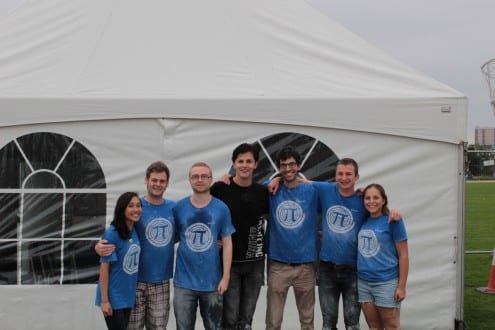This is all maths. Honest.
By ucahpse, on 12 October 2015
On the Sunday and Monday of the August Bank Holiday, UCL held its inaugural Spark Festival at the Olympic Park in Stratford. Filled with stalls representing research from across the STEM subjects (Science, Technology, Engineering and Maths), it was designed to inspire children to become the scientists of tomorrow.
Seven mathematics PhD students – Anna Lambert, Huda Ramli, Matthew Scroggs, Matthew Wright, Oliver Southwick, Pietro Servini and Rafael Prieto Curiel – went along to see whether they could set up some experiments…
In 2012, athletes from across the world dived into the 50 m long swimming pool nestled within the streamlined Aquatic Centre of Stratford’s Olympic Park. The British charge, led largely by Rebecca Adlington, stuttered and sank, with only three medals and none of them gold.
But even they have an easier time swimming than the smallest organisms that inhabit our planet, for whom swimming in water is exactly like us trying to move in corn syrup. Hence their development of long tails (or flagella) that they move in a corkscrew movement in order to propel themselves forwards: were they simply to flick their tails one way and then the other, they would end up right back where they started, never going anywhere.
Not the best way to win in the race called life.
But why swim in a liquid in the first place, when you could just run across it?
We’re mathematicians! We don’t really do experiments – unless you count the simulations we run on computers or the thought processes we carry out in the giant hallways of our minds. For sure, we don’t spend our days in the office filling up inflatable paddling pools with dozens of litres of water and a hundred kilos of cornflour, going slowly crazy as we croak out “Corn!” in the manner of Lord Mormont’s raven in Game of Thrones. Which means that we’re not very good when it comes to optimising the area around the pool that should be covered with a tarpaulin, especially when there are kids around. Or, for that matter, figuring out how to pipette food colouring into a cylinder full of corn syrup – probably the stickiest substance known to humanity[citation needed] – and then take out the pipette without removing the food colouring too, when the whole purpose of the experiment is to show that the flow is reversible and that that is exactly what will happen.
But how else were we to entertain the hundreds of children who attended UCL’s Spark Festival at the Olympic Park over the August Bank Holiday weekend, a two day extravaganza of stalls showcasing an eclectic collection of research being done in the STEM subjects?
And so there we were, surrounded (hopefully) by the young scientists of the future, who were excitedly mixing vials (plastic cups) of sticky food dye together; transferring the semi-solid, semi-liquid mixture of cornflour and water from one bucket to another (and, obviously, to the ground as well); excitedly jumping up and down on the surface of this non-Newtonian fluid in our paddling pool (or falling down in it); whilst we were trying desperately to convince them and their parents that this was indeed all maths.
Which, of course, it is. Our mixture of cornflour and water (also known as oobleck) is an example of a non-Newtonian fluid: where the viscosity (the fluid’s “thickness”) is not constant as it is in air or water, but either increases (as in our case) or decreases (paint, ketchup, toothpaste, blood) as you apply a force to it. The study of these substances is important (or so we tell ourselves) and mathematicians play a key role in modelling their flow to predict what they might do in certain situations.
Shear thickening substances such as ours, for example, are being used to develop the body armour of the future.
Our Taylor-Couette experiment involved a highly viscous fluid (corn syrup) filling the space between an inner rotating cylinder and an outer cylindrical wall and some blobs of differently coloured food dye placed within the gooiness. When the fluid is rotated, the food colouring is mixed together; but rotate now in the opposite direction and the indistinct mess separates out into the original distinct blobs. We have reversible flow, where time doesn’t really matter and frictional forces dominate; and all because the Reynolds number,
is very low. In our Taylor-Couette experiment, this was because the viscosity was very high; but mathematicians use the same equations to model the flow of lava (also high viscosity) or the motion of glaciers (low typical speed) or, yes, the swimming of microbes in water (small length scale).
So how much did we succeed in proving that splashing around in oobleck or getting covered in sticky corn syrup was maths? Who knows! But hopefully we planted that seed of thought that maths is more than what you study in school; that it’s exciting, fun and beautiful; that it can provide stunning insights into the mysteries of nature; and that it can link together things that seem completely different. And at least we succeeding in helping to ensure, as one young girl breathlessly shouted as she frantically tried to stay afloat on our cornflour, that this engineering festival was “way better than Imperial’s!”
Even if we did have to spend Tuesday morning on our hands and knees, scrubbing the ground with a broken broom and chipping away at an inch-thick layer of cornflour on the grass, cursing our inability to properly site a tarpaulin.
 Close
Close






